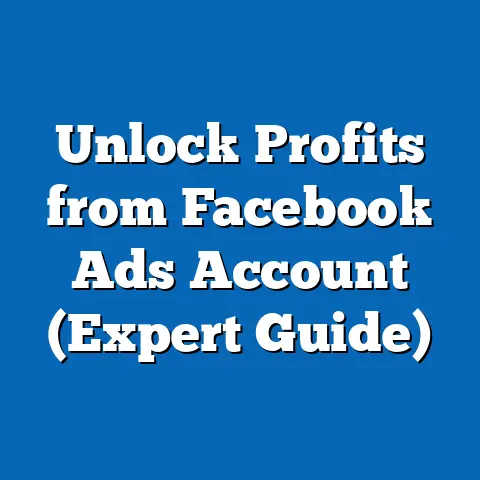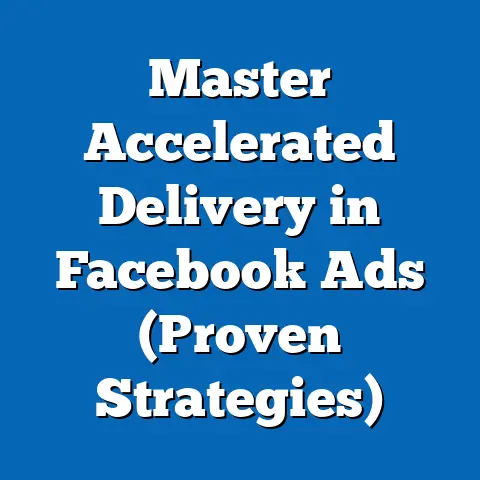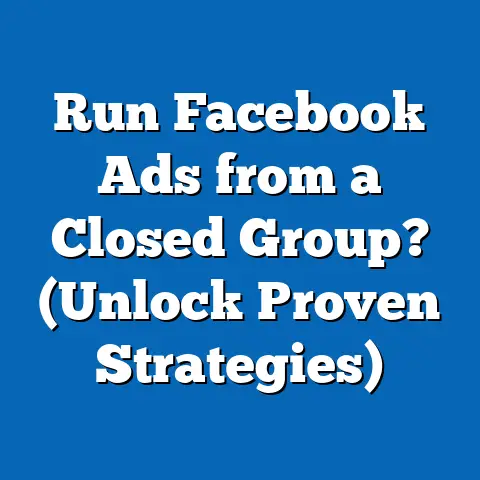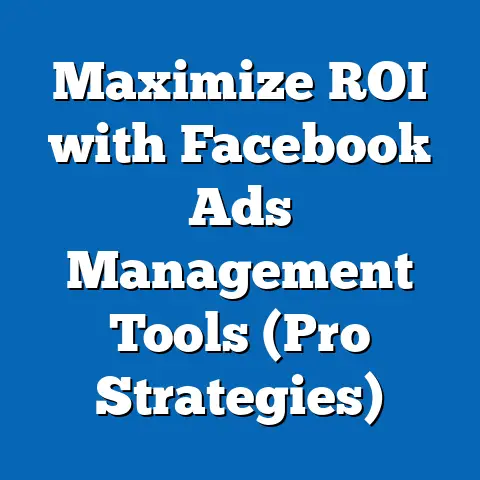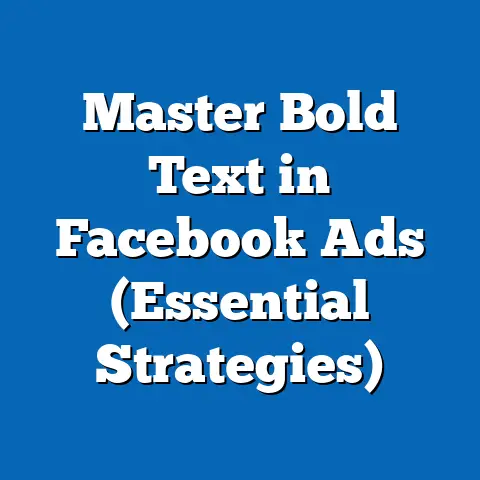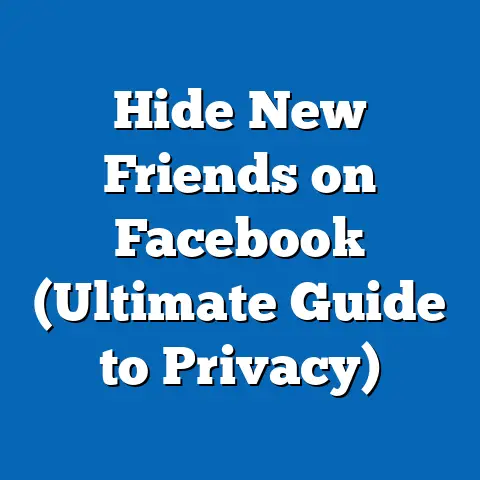Mastering Facebook Ad Management (Essential Tactics Unveiled)
As a digital marketing specialist, I’ve seen firsthand how Facebook advertising can be a game-changer for businesses of all sizes. But let’s be honest, navigating the world of Facebook Ads can feel like navigating a minefield, especially when it comes to budget. I’ve seen countless small businesses and marketers struggle to balance cost and effectiveness, often feeling like they’re throwing money into a black hole.
The truth is, mastering Facebook ad management isn’t just about spending money; it’s about investing it strategically. It’s about understanding the platform, your audience, and the nuances of ad creation and optimization. That’s why I’m here to unveil essential tactics that can help you maximize your ad spend and achieve better results without breaking the bank. Think of it as unlocking the secret to getting more bang for your buck on Facebook. Let’s dive in!
Understanding Facebook Ads
Facebook Ads are the paid marketing messages that businesses use to reach a wider audience on the Facebook platform. They appear in various places, including the news feed, right column, and within Messenger. In the vast landscape of digital marketing, Facebook Ads play a pivotal role because they offer unparalleled reach and targeting capabilities.
Now, let’s talk about the different types of ads available:
- Image Ads: These are your basic, single-image ads. They are simple to create and can be very effective if the image is compelling and relevant.
- Video Ads: Video ads are incredibly engaging and can tell a story in a way that images can’t. They can range from short, attention-grabbing clips to longer, more informative pieces.
- Carousel Ads: Carousel ads allow you to showcase multiple images or videos in a single ad, each with its own headline, description, and link. This format is great for showcasing different products, features, or aspects of your brand.
- Slideshow Ads: These ads use a series of images to create a video-like experience. They are a cost-effective alternative to video ads, as they require fewer resources to produce.
The key to cost-effectiveness with Facebook Ads lies in proper targeting. If you’re showing your ads to people who are genuinely interested in what you have to offer, you’re more likely to see higher engagement and conversion rates. This, in turn, lowers your overall costs and improves your return on investment.
Takeaway: Facebook Ads are a powerful tool, but their effectiveness hinges on understanding the platform and targeting your audience correctly.
Setting a Budget
Setting a clear budget is the cornerstone of any successful Facebook ad campaign. It’s not about how much you can spend, but how much you should spend to achieve your desired outcomes. Without a well-defined budget, you risk overspending without seeing a significant return, or underspending and missing out on valuable opportunities.
Facebook offers two primary budgeting options: daily and lifetime budgets. A daily budget sets the amount you’re willing to spend on your ads each day. This is a good option if you want to run your ads continuously and maintain a consistent level of activity. On the other hand, a lifetime budget sets the total amount you’re willing to spend over the entire duration of your campaign. This is useful if you have a specific start and end date in mind, such as for a limited-time promotion.
When deciding on your budget, consider these factors:
- Business Goals: What are you trying to achieve with your ads? Are you looking to generate leads, drive sales, or increase brand awareness? Your budget should align with your goals. For example, if you’re aiming for high-value conversions, you may need a larger budget to reach a more targeted audience.
- Audience Size: The size of your target audience will directly impact your budget. A larger audience requires a larger budget to reach effectively.
- Ad Objectives: Different ad objectives (e.g., traffic, engagement, conversions) have different costs associated with them. Understand the average cost per result for your chosen objective and adjust your budget accordingly.
In addition to budgeting options, Facebook also offers different bid strategies. Cost Per Click (CPC) bidding means you pay each time someone clicks on your ad. This is a good option if you’re focused on driving traffic to your website. Cost Per Mille (CPM) bidding, on the other hand, means you pay for every 1,000 impressions your ad receives. This is better suited for brand awareness campaigns where the goal is to get your ad seen by as many people as possible.
Choosing the right bid strategy can significantly impact your overall costs. If you’re new to Facebook Ads, I recommend starting with CPC bidding, as it allows you to control your costs more directly. As you gain more experience, you can experiment with other bid strategies to see what works best for your specific goals.
Takeaway: A well-defined budget is essential for cost-effective Facebook advertising. Consider your business goals, audience size, and ad objectives when setting your budget, and choose a bid strategy that aligns with your needs.
Crafting Effective Ad Copy and Creative
Now, let’s talk about the heart and soul of your Facebook Ads: the ad copy and creative. No matter how well you target your audience or how big your budget is, if your ads aren’t engaging and compelling, you won’t see the results you’re looking for. It’s like having a perfectly aimed arrow but a flimsy bow – you need both to hit the target.
Effective ad copy is clear, concise, and relevant to your target audience. It should immediately grab their attention and communicate the value of your offer. Think about the problems your product or service solves and highlight those benefits in your ad copy. Use strong, action-oriented language that encourages people to click and learn more.
Visuals are equally important. In fact, studies have shown that visuals are processed 60,000 times faster than text. That means your images or videos have a split second to capture someone’s attention as they scroll through their news feed. Use high-quality images or videos that are visually appealing and relevant to your offer.
But it’s not enough to just create good ads; you need to test different variations to see what works best. This is where A/B testing comes in. A/B testing involves creating two or more versions of your ad with slight variations (e.g., different headlines, images, or calls-to-action) and running them simultaneously to see which performs better.
Here are some tips for writing compelling headlines, clear calls-to-action, and engaging visuals:
- Headlines: Keep your headlines short, punchy, and attention-grabbing. Use numbers, questions, or strong verbs to pique people’s interest.
- Calls-to-Action: Make your calls-to-action clear and specific. Tell people exactly what you want them to do (e.g., “Shop Now,” “Learn More,” “Sign Up Today”).
- Visuals: Use high-quality images or videos that are visually appealing and relevant to your offer. Make sure your visuals are optimized for mobile devices, as most people will be seeing your ads on their phones.
Remember, the key is to align your ad content with user intent. Think about what people are looking for when they see your ad and tailor your message accordingly. If you’re selling running shoes, for example, you might target people who are interested in fitness or running and create ads that highlight the comfort, performance, and durability of your shoes.
Takeaway: Compelling ad copy and creative are essential for driving conversions and maximizing your ad spend. Use A/B testing to find the most effective combination and align your content with user intent.
Targeting the Right Audience
Targeting the right audience is where Facebook Ads truly shine. It’s the secret sauce that allows you to reach the people who are most likely to be interested in your product or service, saving you money and maximizing your return on investment. I’ve seen campaigns go from floundering to flourishing simply by refining the targeting.
Facebook offers a wide range of audience targeting options, including:
- Demographics: Target people based on age, gender, education, relationship status, and other demographic factors.
- Interests: Target people based on their interests, hobbies, and passions.
- Behaviors: Target people based on their online behavior, such as their purchase history, device usage, and travel habits.
- Custom Audiences: Create custom audiences by uploading your own customer data (e.g., email addresses, phone numbers) or by targeting people who have interacted with your website or Facebook page.
- Lookalike Audiences: Create lookalike audiences by targeting people who share similar characteristics with your existing customers or website visitors.
Custom audiences and lookalike audiences are particularly powerful for maximizing ad spend. Custom audiences allow you to target your existing customers or people who have already shown an interest in your brand. Lookalike audiences allow you to expand your reach by targeting people who are similar to your best customers.
Here are some tactics for refining audience targeting to ensure that your ads reach potential customers who are most likely to convert:
- Start Broad, Then Narrow Down: Begin by targeting a broad audience based on demographics and interests, then gradually narrow down your targeting based on performance data.
- Use Layered Targeting: Layer multiple targeting options to create a more specific audience. For example, you could target people who are interested in fitness and who have recently purchased athletic apparel online.
- Exclude Irrelevant Audiences: Exclude audiences that are unlikely to convert. For example, if you’re selling high-end products, you might exclude people with lower income levels.
- Test Different Audiences: Test different audience combinations to see which performs best. Use A/B testing to compare the performance of different audiences and refine your targeting accordingly.
I remember working with a local bakery that was struggling to attract new customers. They were running Facebook Ads targeting everyone in their city, but their results were underwhelming. After analyzing their customer data, we discovered that their most loyal customers were women aged 25-45 who were interested in baking, cooking, and healthy eating.
We created a custom audience based on this data and a lookalike audience to expand their reach. We then created ads that highlighted the bakery’s fresh, homemade ingredients and healthy options. As a result, their cost-per-acquisition decreased by 50%, and they saw a significant increase in sales.
Takeaway: Targeting the right audience is crucial for maximizing ad spend. Use Facebook’s targeting options to reach the people who are most likely to be interested in your product or service, and refine your targeting based on performance data.
Analyzing and Optimizing Campaign Performance
The final piece of the puzzle is analyzing and optimizing your campaign performance. It’s not enough to just set up your ads and let them run; you need to constantly monitor their performance and make adjustments as needed. Think of it as tending a garden – you need to water, weed, and prune to ensure that your plants thrive.
Key Performance Indicators (KPIs) are the metrics you’ll use to track the success of your campaigns. Some of the most important KPIs for Facebook Ads include:
- Click-Through Rate (CTR): The percentage of people who see your ad and click on it. A higher CTR indicates that your ad is relevant and engaging.
- Conversion Rate: The percentage of people who click on your ad and complete a desired action (e.g., make a purchase, sign up for a newsletter). A higher conversion rate indicates that your landing page is effective and your offer is compelling.
- Cost Per Acquisition (CPA): The cost of acquiring a new customer through your ads. A lower CPA indicates that your campaigns are cost-effective.
- Return on Ad Spend (ROAS): The amount of revenue you generate for every dollar you spend on ads. A higher ROAS indicates that your campaigns are profitable.
Facebook Ads Manager is your go-to tool for monitoring campaign performance and making data-driven decisions. It provides a wealth of data on your ads, including impressions, clicks, conversions, and cost metrics. Use Ads Manager to track your KPIs, identify underperforming ads, and make adjustments to improve your results.
Here are some strategies for optimizing your campaigns based on performance data:
- Adjust Targeting: If your ads aren’t reaching the right people, refine your targeting options.
- Revise Ad Copy: If your ads aren’t generating enough clicks, experiment with different headlines, descriptions, and calls-to-action.
- Update Visuals: If your ads aren’t visually appealing, try using different images or videos.
- Reallocate Budget: If some of your ads are performing better than others, reallocate your budget to focus on the top performers.
- Pause Underperforming Ads: If some of your ads are consistently underperforming, pause them to avoid wasting money.
The key is to embrace a continuous cycle of testing, analyzing, and optimizing. Don’t be afraid to experiment with different strategies and see what works best for your specific goals. The more you test and analyze, the better you’ll understand your audience and the more effective your campaigns will become.
Takeaway: Analyzing and optimizing campaign performance is an ongoing process. Track your KPIs, use Facebook Ads Manager to monitor your results, and make adjustments as needed to improve your cost-effectiveness over time.
Conclusion
Mastering Facebook ad management is a journey, not a destination. It requires a combination of knowledge, skills, and a willingness to experiment and learn. I’ve shared some essential tactics that can help you get started, but the real magic happens when you apply these tactics to your own campaigns and see the results firsthand.
Remember, cost-effective Facebook advertising is not about spending less money; it’s about spending your money wisely. By understanding the platform, targeting your audience effectively, crafting compelling ads, and continuously analyzing and optimizing your performance, you can harness the power of Facebook Ads to achieve your marketing goals without breaking the bank.
So, go forth and conquer the world of Facebook advertising. With the right knowledge and approach, you can unlock the potential of this powerful platform and achieve the results you’ve always dreamed of. Good luck, and happy advertising!

